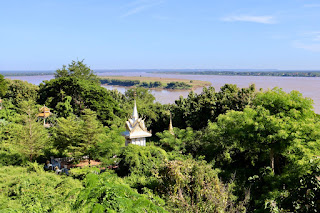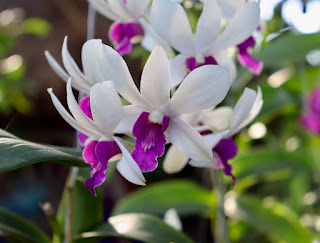The routine returned today and we are scheduled to visit two villages, after the usual 8:30am departure. The first was Wat Hanchey, another not-so-poor village, judging by the stupas and the size of the houses. Disembarking from the ship was a bit agricultural. The permanent moorings appear to be functional only during the monsoon season. The challenge this morning, dear reader, was to ascend the 302 steps to the top of the hill to see the temple.
 |
| It was as steep as it looked. |
Challenge accepted. I was standing admiring the view in less than 9 minutes. Perhaps I was a tad breathless. The breeze at the top was most welcome. The view was worth the climb. It provided a panoramic vista over the river valley and the extent of the temple precinct. The steps had been divided into three sections and at each landing the depth of the tread of the step increased in height. While that had little impact on the descent, it didn’t make the ascent any easier.
 |
| The temple at the top of the steps. |
There was also an easier method of climbing the mountain. A bus ride. Jayne informs me that the bus was oversubscribed and some people were ejected to face the 302 steps. Very average organisation. The bus had many vacant seats on the return journey as more opted to walk. Our guides had no idea who was where. Risky.
 |
| The view from the top. |
The temple area was quite extensive and dated back thousands of years. Much of the original structures had been damaged by bombing during the American war. Areas of Cambodia were collateral damage as they say. The main temple has been rebuilt and some of the more significant historic structures are being restored, although Jayne thought the restoration attempt looked like a pile of Jenga blocks.
 |
| Still standing. |
The surprise as you reached the temple precinct was the swarm of children that assailed you in search of gifts. We came unprepared. Fear not, the locals have this aspect covered. For the measly cost of $10USD you can buy a packet of colouring books or writing pads or a packet of 24 textas to give to the children. An open wallet is like waving a chip at a Circular Quay seagull. The kids swarm grabbing for a book.
 |
| Another temple. |
This is a perfect example of a circular economy. You pay for the books and distribute them to the children, who, potentially return them to their parents to be re-packaged and sold to another group of unsuspecting tourists. We were assured that this never happens. I’m not so certain, but it is a good stimulus for their economy. Either way, it is a win-win for the children who apparently get the money and the book/textas.
 |
| The monks' house. |
Back on board the ship, we spent some time on our verandah, re-hydrating with a local beer. Purely for health reasons you understand. It was the first time we’d spent any substantial amount of time out there. To date it has been used to dry washing and to acclimatise my camera to the humidity of the day. It was quite pleasant and there was a small breeze created by the movement of the ship as we made our way back down the river.
 |
| Heading down. |
Of course, we were fed before our next excursion. I’ve taken to minimising breakfast and lunch, if for no other reason than to leave space for dinner.
Kampong Cham was our next port of call. Once again, there was no permanent mooring for the ship. In fact, there was a path made from bamboo that tracked across the muddy bank. The gangway was lowered and the crew made themselves busy re-sculpturing the bank to ensure ease of disembarkation. This is also the place where we will leave the ship and the next group will embark. Not the most salubrious of places to do it, compared to the marina at the other end.
 |
| The bamboo path near the gangway. |
Our mode of transport switched back to the more traditional tuk tuk. The convoy headed off for the island, taking a circuitous, scenic route, which apparently did not please our guide. Words were exchanged and we were taken directly to our destination.
 |
| Our chariot. |
Kampong Cham is an island that has only recently been connected to the mainland by a proper bridge. The previous structure was made of bamboo. I’m not sure my travel insurance would have covered me, had there been an accident. The new bridge was another “gift” from China, like the stadium in Phnom Penh. How lovely of China. All these multi-million dollar presents. No strings attached. Unless of course you consider staying mum about China building dams on the upper Mekong River and stealing the water from Vietnam and Cambodia to be ‘strings’. Jayne was highly amused that China provided money for a bridge that may soon be superfluous because they are damming the river and there will be no water to cross.
 |
| Community farming. |
As we have progressed on our journey, we are visiting more and more affluent villages. Kampong Cham was the pinnacle. The home we visited was an example of subsistence living. Supposedly. It was a two-story house with limited under-croft because some of it had been enclosed. There was also solar power and air-conditioning and a reasonably new Toyota Landcruiser parked in the driveway.
They had some lovely orchids growing out the front of the house. The backyard contained numerous fruit trees and other cropping plants. There were pomelos, coconuts, lemon grass, ginger, limes, turmeric, mangoes, bananas and no doubt more, but I can’t remember. The backyard that contained the plants went through to the river where a well provided groundwater for irrigation. Apparently, they also had a bull that was used for insemination purposes, but he must have been out on a job, so to speak.
 |
| Some of the orchids. |
The fruit and crops would bring an average of $15USD per day. In a leap year that is $5,490USD. I’m sure APT pays them handsomely to open their home and talk to us. But. But. I can’t see how that lifestyle can support the purchase of solar panels and a Landcruiser.
 |
| Coconuts. |
The tuk tuk ride back to the ship was by a more direct route. We passed many palatial two-story residences that had massive chandeliers hanging in the upstairs front porches. Subsistence farming must pay better than my maths indicates.
 |
| Ginger, not Maryanne. |
That afternoon we packed our bags ready for disembarkation tomorrow morning. That evening, at the farewell cocktail party, the whole crew was presented to us once again. Long gave his final briefing, predictably not so brief, on board and provided us with a lot of unnecessary information about the next three days. He had to be prompted to inform us of the important details, like what time do the bags need to be ready and what time is breakfast?
 |
| Turmeric and solar panels. |
And then it was the final dinner where I learnt a new term. One of the meals on offer was barramundi and slipper lobster. I’d never heard the latter term. Fortunately, one of the chefs explains the menu selection as you walk into the dining room. To aid in this endeavour is a table that holds each of the dishes. A slipper lobster is our Balmain bug or Moreton bug if you’re a Queenslander.
We said our farewells to our favourite staff and retired to our stateroom, not cabin, to complete packing. The bags have to be outside our door by no later than 6:15 tomorrow morning. Breakfast will be served from that time. Holiday indeed.
The farewells inspired the title. A Jeff Buckley classic from his first album Grace, Last Goodbye. Like his father, gone too soon from this world.
Until next time.

No comments:
Post a Comment